This post is for all you gardeners. It will cover the progress made with getting things planted as well as what new trees have started to produce fruit over the last year.
Before I get going I need to make clear, we do not operate a commercial nursery. This is strictly for our personal enjoyment. Occasionally, I will put a few of my surplus plants up for sale, over on Craigslist Puerto Rico. You can also email me via the Contact Page, if interested. These are ‘one-time’ only sales. At some point, I hope to put the planting of new trees behind me.
But first a few words about grabbing photos around the property
When I’m out doing ‘dirt-work’, it’s been hard to keep up with shooting images of the progress. I don’t like dragging my good camera gear around or risk getting it dirty in the process.  Plus there is a need to travel light while working. If I don’t keep it on me, I miss key shots. I had an old Canon S-80 ‘point and shoot’ in a waterproof housing, but it was quite bulky. Plus, I accidentally destroyed it a while back so I needed to replace it.
Plus there is a need to travel light while working. If I don’t keep it on me, I miss key shots. I had an old Canon S-80 ‘point and shoot’ in a waterproof housing, but it was quite bulky. Plus, I accidentally destroyed it a while back so I needed to replace it.
The new category of waterproof (or really, water-resistant) cameras have come a long way over the last 5 years. So I thought it was time to pick one up. I scored a 16MP, auto-focus Olympus Stylus Tough 860. Most of these point and shoots don’t have a very wide lens… I like wide. This one goes from 21mm to 105mm (35mm equivalent). The widest in the waterproof camera category. It also has a ‘macro’ mode for getting in close. The little 860 will also shoot video though I don’t really care about that. 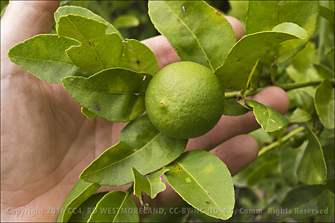 I have seen this model sell for well below $200 on eBay. Pretty cheap for what it will do.
I have seen this model sell for well below $200 on eBay. Pretty cheap for what it will do.
All that sounds good on paper. But how does it perform?
Only so-so. Overall image quality is only ‘fair’, sorry to say. Since I’m using it for the Blog and sizing them down in Photoshop, I can do a lot to improve the final image. It will NEVER replace my Sony NEX-7. Auto-focus works well for general picture taking, but fails at very close ranges… under 2 feet. Especially when the background is more than 5 or 6 feet away. I wish I could focus manually for close-ups, but that’s not an option.
Bottomline- It’s ‘just’ ok for what I got it for… shooting while working outside under harsh conditions.
There are much better, though more expensive waterproof cameras to choose from.
If you want to get busy creating great images, buy something with a larger image sensor and a good lens.
Or stick to your cell. Image quality is on a par with a good smart-phone.
Which leads to the obvious question- why not my iPhone?
First, I don’t take my old iPhone 3s with me when I work outside. Most of the time, I don’t even turn it on. Second, reception down in the hoya is absolutely abysmal so why bring it anyway? and Third, I needed something relatively mud and dirt proof. How often do you rinse off your cell with a hose?
Most of the garden shots are now done with the Olympus 860. It does the job. Just know it should never be your only camera.
The big payoff.. What’s beginning to fruit
 After 6 years of starting seeds and planting trees, I have several that are starting to produce. A few pieces of fruit is a good sign, right? In fact some started to fruit while still in the pot.
After 6 years of starting seeds and planting trees, I have several that are starting to produce. A few pieces of fruit is a good sign, right? In fact some started to fruit while still in the pot.
That certainly served as motivation to get them planted.
So far, the Star fruit, Pitahaya, Blackberry Jam tree, Rainforest Plum, Phalsa, Cashew, Sacha Inchi vine and Jobo (Hog Plum) have started producing.
The Star Fruit (Carambola) was a real surprise. I was out on the mower, trimming around the small trees when one of the ripe fruit, almost hit me in the knee. Those 10 fruit were the first it produced. I have 3 trees of which 2 are showing fruit. Carambola is a rather hit or miss tree. Most people grow them from cuttings since the tree may not be true to the seed. 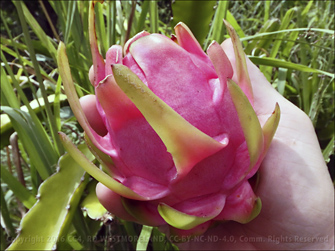 A sweet fruiting tree can produce seeds that produce a sour tasting fruit. If you grow from seed like I did, you will not know what you got until you actually try it. Thankfully, my 1st tree produces sweet, mild tasting fruit. I have my fingers crossed, the other two will be ok.
A sweet fruiting tree can produce seeds that produce a sour tasting fruit. If you grow from seed like I did, you will not know what you got until you actually try it. Thankfully, my 1st tree produces sweet, mild tasting fruit. I have my fingers crossed, the other two will be ok.
I have a total of 5 Pitahaya cacti. Two produce white fruit and 3 produce a dark magenta colored fruit. The white ones were planted a year before the magenta variety and are now showing fruit. If you’ve never tried it, the flesh has the consistency of Kiwi fruit, but not as sweet or tart. A mild flavor that is perfect mixed with other fruit or eaten with a spoon, straight from the chilled, split fruit. Like you would a melon. I think it would be great with vanilla ice-cream.
The Blackberry Jam tree (Rosenbergiodendrom formosum) is quite a novelty. I have 3 of these bush-like trees. The small fruit produces a dark purple pulp that does resemble Blackberry jam. The fruit is sweet tasting, not tart at all with no aftertaste. No, it does not taste like Blackberries. The flavor is mild and tropical. Each little fruit will have between 7 to 10 seeds per, so you break the thin, cardboard-like outer shell, squeeze the pulp into your mouth and work it around until you can spit out the seeds. I like it. When we have more, we plan to put the pulp through our electric fruit processor. This should strip the seeds away leaving us with something we can turn into jam or freeze and add to smoothies later.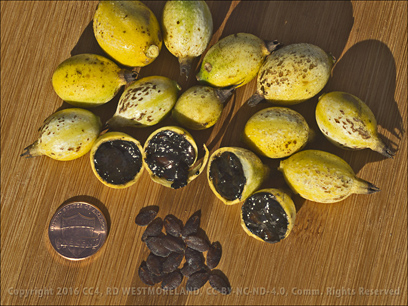
We got exactly 3 fruit off the Rainforest Plum (Eugenia candolleana). I’m sure if it had been in the ground, it would have done a lot better. It is now. The fruit more resemble a Choke cherry in size, taste and texture, though the pulp is not red. The fruit has one medium sized seed in the middle, as well. They were very sweet, slightly tart and very flavorful. I have only one example of this tree. It is about 3 feet tall and about 2.5 feet in diameter. In another 2 years, it should be doing real well.
Phalsa (Grewia asiatica) is an Asian species grown for it’s small fruits. They are eaten out of hand or dried and used to flavor cooked dishes. It also possesses some medicinal properties. I can say it loves it here and has turned into quite the lush bush. There are many cultivars within the Phalsa category. Most are not available to the West. I expect to gather enough berries next year, to do something with them.
Cashew trees are very common in Puerto Rico. They are almost as common as the wild Mango (Mango Bobo) or Tropical Almond. I have 3 in pots of which one tossed a stunted, dwarf-like fruit with nut. Locally, they eat the fruit or ‘apple’ and toss the nut hanging off the bottom. Processing the nut is not something you do with your bare hands as the outside shell is caustic and will burn your skin. That does explain why the locals don’t mess with it. Once I discovered every nut comes with a large piece of fruit attached, I realized somewhere, somebody is throwing away a lot of fruit… 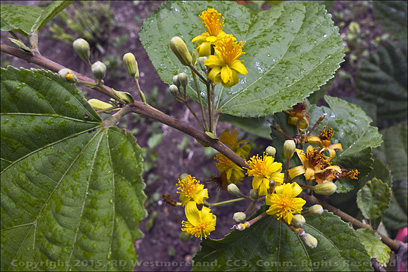 to get to the cans of nuts we so casually take for granted. That leads to a bunch more questions about their harvest, but I don’t have the room to explore that subject here. These three trees will go in the ground soon.
to get to the cans of nuts we so casually take for granted. That leads to a bunch more questions about their harvest, but I don’t have the room to explore that subject here. These three trees will go in the ground soon.
The Sacha Inchi (Plukenetia volubilis) vine from Chile, almost died from the drought of a year ago. It came back and produced 4 seed pods total (without adding any extra nutrients). I retrieved the edible seeds in hopes of starting more vines. The nutlike seed is supposed to be very delicious. It thrived as long as it got water. It took 2 years for the vine to go from seed to seed. I will plant more.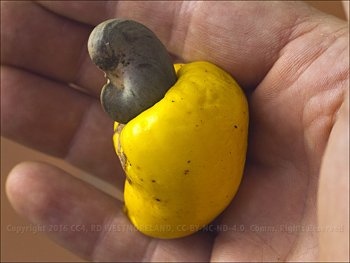
Jobo (or Hog plum- Spondias mombin) is another common local tree. There are actually two varieties or cultivars (I’m not sure which). One produces fruit that is a lot smaller than the other. It is often referred to as Joboito. We have both growing wild on our property. In my zeal to start seeds, I had scored some before I realized we already had it growing here. Of the two plants I had in pots, I gave one away. I’ll plant the other one in the near future. Not everyone likes this fruit because the seeds are huge, without much fruit pulp. That said, it is an excellent food for farm animals, should we ever get any.
New Trees, in the Ground
Most of the things discussed above went into the ground 2 to 3 years ago.
In part 1, I covered the fact I’ve been working at clearing off the little road down to the hoya.
That has given me room to plant a bunch more things.
Namely- 3 African Mangosteen (Imbe), 5 Lemon-drop Mangosteen, A single Paradise Nut, a single Jabuticaba, about 8 Burmese Timber bamboo and 7 Ornamental Ginger. I also planted 2 Allspice in the west garden patch.
The Burmese Timber bamboo (Bambusa nutans) and Ornamental Ginger were planted next to a steep hill that was being undercut by rain runoff. They should help with soil erosion. I spread them too far apart, so I will go back and add another 7-8 bamboo plants to the row. 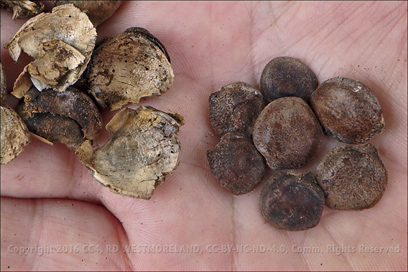 Bambusa Nutans is excellent for medium weight construction projects like furniture and the shoots are edible. I have a lot of these, so I’m trying to place them where they will not overtake other trees and plants. B. Nutans is a ‘clumper’ so It should not spread out very far. As the bamboo matures, I will be pulling out most of the Ornamental Ginger. It grows faster than the bamboo so it’s roots will help secure the soil ahead of the bamboo. It takes bamboo, 5 to 7 seasons to achieve a mature diameter. Each year, the culms are a little bigger and a little taller than the year before.
Bambusa Nutans is excellent for medium weight construction projects like furniture and the shoots are edible. I have a lot of these, so I’m trying to place them where they will not overtake other trees and plants. B. Nutans is a ‘clumper’ so It should not spread out very far. As the bamboo matures, I will be pulling out most of the Ornamental Ginger. It grows faster than the bamboo so it’s roots will help secure the soil ahead of the bamboo. It takes bamboo, 5 to 7 seasons to achieve a mature diameter. Each year, the culms are a little bigger and a little taller than the year before.
Most tropicals need lots of water. They do not like droughts or long dry spells.
If we lived up in the mountains, this would not be a problem.
Unfortunately, the Dry Season where we are can be very dry… weeks without any rain.
To address this issue, I looked at several fruit and nut producing trees from Africa.
The African Mangosteen (Imbe/ Garcinia livingstonei) is one of those that should do well under our drier conditions. It looks like a giant version of the smaller Lemon-drop Mangosteen. I think it almost ironic that I scored my 3 Imbe seeds off the ground of the Mayaguez Botanical Research Center Gardens (USDA-TARS). They have two giant old growth trees that look like one humongous tree. 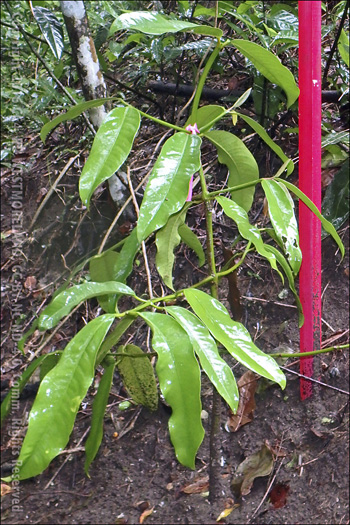 The fermenting fruit covered the ground by the 1,000’s. The fruit resembles a small peach, but without the fuzz. I did not realize until later that these will be either male or female plants. If I end up with 3 of the same, I’ll try my hand at grafting the opposite sex to one. Same for the Lemon-Drop (Garcinia intermedia) cultivar. Fortunately, I have 5 of those. Yes, once I know what I have, I can cut out any extra males, leaving room for the females. Though that could take years. Both of these are from the Gardenia family
The fermenting fruit covered the ground by the 1,000’s. The fruit resembles a small peach, but without the fuzz. I did not realize until later that these will be either male or female plants. If I end up with 3 of the same, I’ll try my hand at grafting the opposite sex to one. Same for the Lemon-Drop (Garcinia intermedia) cultivar. Fortunately, I have 5 of those. Yes, once I know what I have, I can cut out any extra males, leaving room for the females. Though that could take years. Both of these are from the Gardenia family
My single Argan Oil tree (Argania spinosa L.) is also of African origin. The oil from the nut has many health benefits. Most recently, it has been popularized as an additive to cosmetics. I’m sure you’ve seen the ads. Then there are the infamous shots of goats climbing on them – as many as 20 in one small tree. That is kind of a surprise as they are covered in tiny thorns. It can be a very twisted, tortured looking tree. They don’t get very big.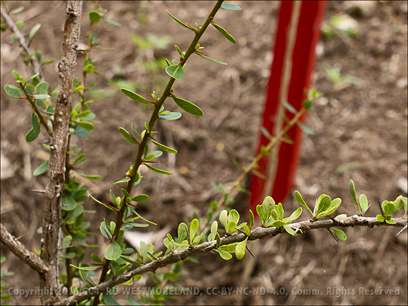
The Paradise Tree (Simarouba glauca) produces an oily nut that can be pressed and used to cook with. Much like Coconut or Almond oil. It’s reputed to be very nutritious, very yummy. The oil is said to stand up to high heat without smoking. How cool is that? I had 3 of these, but 2 died from neglect. So I’m down to one specimen. Fortunately, it’s in the ground now.
Planted in close proximity to the Paradise Nut is a single Jabuticaba (‘J’ is hah, almost silent- Plinia cauliflora). A fruiting tree that should be in every tropical collection. I have a cultivar from Hawaii that is supposed to be a ‘quick-fruiting’ variety. Most take 8 to 10 years before they begin to fruit.  But when they do, step back. Even a small tree can produce hundreds of fruit. They look like a large grape the size of a golfball.
But when they do, step back. Even a small tree can produce hundreds of fruit. They look like a large grape the size of a golfball.
I now have two Allspice (Pimenta dioica) trees in the ground. When I make Green tea, I like to put a few crushed Allspice seeds in with it. These two seem to be doing well, as long as I keep them watered regularly.
Last, but not least, I have a single Orlando seedless grape vine. A friend from Hawaii, sent me a cutting from one of his plants. He also sent me all the Fig cuttings I started. Awesome. I created a small patch, just for the seedless grape. In a couple of years, I should be able to take additional cuttings so I can grow more of it. That went into the garden on the east side of the house. 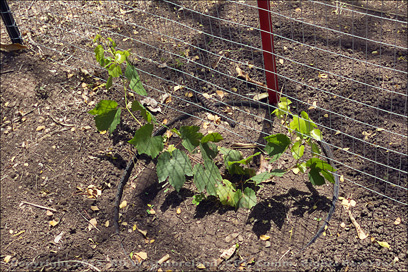 I still need to plant the potted Fig cuttings. Several of them have also started to fruit. It would appear that these will be quite prolific, once I get them in the ground.
I still need to plant the potted Fig cuttings. Several of them have also started to fruit. It would appear that these will be quite prolific, once I get them in the ground.
I did save some space along the old dirt road for my 8 Cacao (chocolate) and 8 Papaya (lechosa). That should happen before the end of the year.
We also harvested several more Pineapples and a bunch more of Puerto Rican Lemons over the last year.
I plan to double the Pineapple patch. They are soo simple to grow and maintain. Though the plant only produces one fruit, the old plant will toss off a new shoot or 2 and start the process all over again. 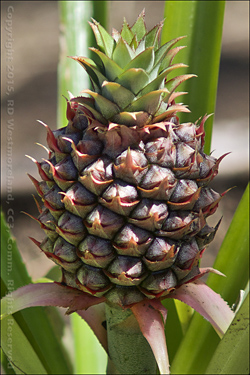 So I’m saving the tops off the local ones we buy. You start them by putting the bottom of the cutoff top in a plastic cup of water. Once they have a healthy amount of roots showing, they go in the ground. Very simple. Pineapple likes lot of sun.
So I’m saving the tops off the local ones we buy. You start them by putting the bottom of the cutoff top in a plastic cup of water. Once they have a healthy amount of roots showing, they go in the ground. Very simple. Pineapple likes lot of sun.
Pineapple is a cash crop here in PR.
The one Noni tree produced fruit before it got planted and never stopped. It continuously fruits. I started with 4, then realized I only needed one. Noni is a very controversial choice, must people don’t bother growing it. Then others think I should have kept all 4. One is plenty!! I’ve featured it in a previous post.
Another local plant that’s gone bonkers is Chiltepin (Capsicum annuum var. glabriusculum) or Bird Peppers. They are popular in Mexico and Texas. We always had one or two plants growing on their own, but now there are at least a dozen. I dug a few up and gave them their own dedicated spots. Plus I gave away several too.  It grows as a woody little bush. The thin stems are very brittle. Fortunately, it is a pretty hardy plant. It will grow new branches in just a few weeks. The peppers are every bit as hot as Habaneros, they are locally known as Caballeros. I like grinding a few up, then sprinkle it into my Guacamole. My doc sez I need to eat less hot peppers so I have a surplus at this point. I think I could make my own pepper spray from them. Chiltepin will easily grow as a potted plant if you give them a sunny spot.
It grows as a woody little bush. The thin stems are very brittle. Fortunately, it is a pretty hardy plant. It will grow new branches in just a few weeks. The peppers are every bit as hot as Habaneros, they are locally known as Caballeros. I like grinding a few up, then sprinkle it into my Guacamole. My doc sez I need to eat less hot peppers so I have a surplus at this point. I think I could make my own pepper spray from them. Chiltepin will easily grow as a potted plant if you give them a sunny spot.
New Seedlings
I decided to start some Lechosa (Carica papaya) as it pretty much grows on it’s own here. I can alternate them with the more permanent Cacao.
The big score was some Jujube (Ziziphus jujuba) fruit and seeds from a friend in California. Jujube is similar to Dates or Tamarind as it is usually dried before eating. The flavor and texture improves with drying. I had tried 2 times before, to grow it from seed. All failed. 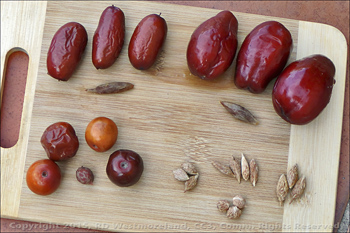 Even with the great collection my pal sent me, I got just 6 to sprout. Hey, that’s 6 more than I had before. Woo Hoo!!!! Seeds of Jujube need to be very fresh. Even at that, many varieties of Jujube produce sterile seeds. Most Jujube is propagated from cuttings like Fig. These need another year before I put them in the ground.
Even with the great collection my pal sent me, I got just 6 to sprout. Hey, that’s 6 more than I had before. Woo Hoo!!!! Seeds of Jujube need to be very fresh. Even at that, many varieties of Jujube produce sterile seeds. Most Jujube is propagated from cuttings like Fig. These need another year before I put them in the ground.
A nice addition to the collection.
I have a short list of things I’m still looking for. I never got Green Tea to survive my starter trays. They would sprout, then slowly die, one at a time. Same for Rambutan or Pulasan. I have exactly one Rambutan tree to plant. The problem with it is, they are male or female.  Another candidate for grafting, I guess. It may be that my growing conditions are not compatible with these 3. It happens.
Another candidate for grafting, I guess. It may be that my growing conditions are not compatible with these 3. It happens.
This pretty much covers where we are at now.
The plan is to hire a little part-time help so I can finish the job of planting the rest by the beginning of Spring.
I’ll do an update about those, once that’s done.
Anyone need a few Aloe Vera plants?
Next up- Our Slice of Paradise: Bob’s Projects part 3/3
CL Barrier says
I always so enjoy your sharing of your Puerto Rican journey- Great Story. Thanks, S.Dog
Essie says
Thank you for your fantastic blog! I am moving to Puerto Rico early next year, the eastern side, and I was hoping to grow pineapples. Your blog is an amazing resource and I really enjoy it. S.Dog- Growing Pinapple should be easy. Fresh off the plant is awesome.